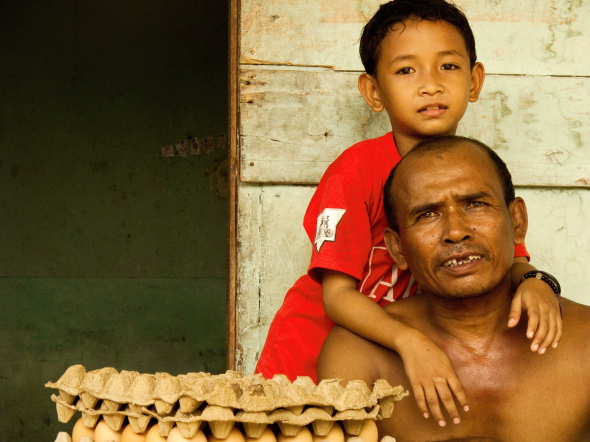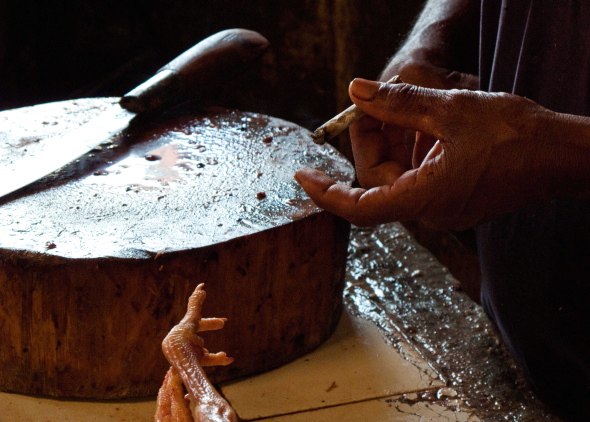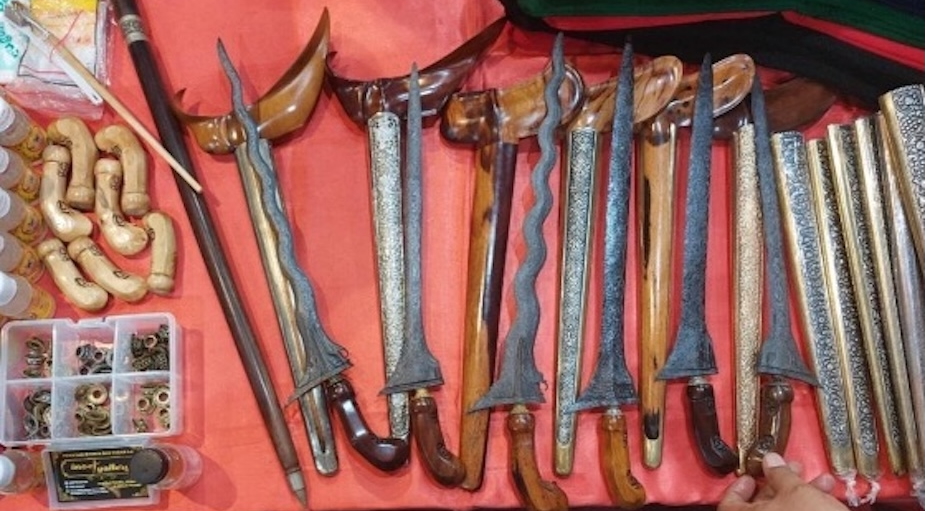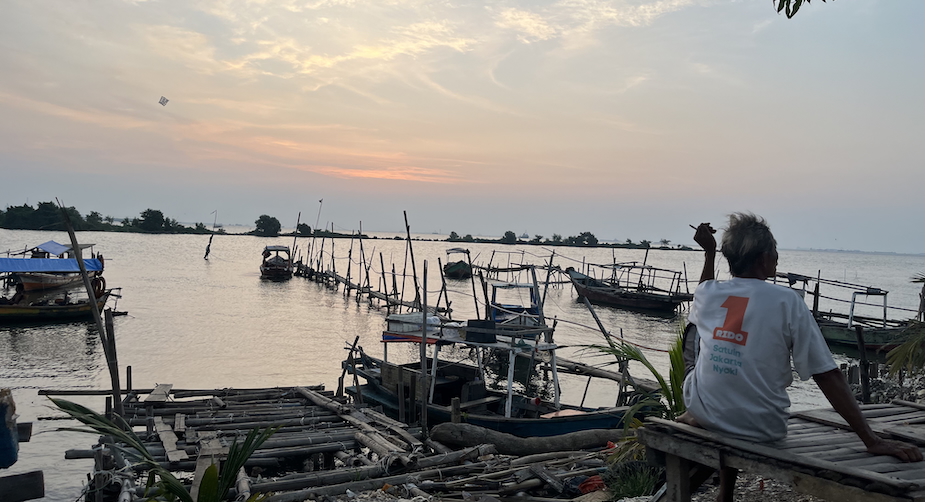Efforts to control avian influenza need to consider the importance of birds in Indonesians’ lives
Scott Naysmith
Every day in every district in Indonesia birds are brought fromsurrounding communities to a central marketplace but not all will besoldScott Naysmith |
Rizal, a small-scale commercial poultry farmer in Aceh, employs twelve people in his village. As his two-year-old son stumbles after chickens just beyond arm’s length he spreads a young chick’s wings to reveal discoloration in the breast and comments on how often disease occurs. He knows when his birds are sick and routinely dilutes powdered vitamins in water to promote good health among his flock. He wants to know what else he can do to protect the source of his livelihood.
Five years ago Rizal borrowed money from the community to buy twelve chickens and build a barn. He now owns over 6000 birds. These birds are housed in the six palm-thatched open walled structures that line the back perimeter of his property. Rizal encloses the large coops with plastic sheeting to block colder winds that he fears carry disease in the rainy season. Each structure is elevated about a metre off the ground and the floor is made of rough split boards. There is a two to three inch gap between each board, allowing droppings, a commonly used fertilizer, to collect beneath the structures. Poultry droppings are an effective vector for spreading the H5N1 virus – avian influenza.
Global concerns, broad prescriptions
Over US$ 2 billion has been mobilised to contain the global spread of H5N1. The vast majority of these funds have been allocated to controlling the virus in East and Southeast Asia, where morbidity and mortality are concentrated. H5N1 was detected in Indonesia in 2003. The first human death was reported two years later. The virus is believed endemic in poultry flocks in 31 of the country’s 33 provinces. To date, Indonesia has more confirmed infections in humans and in poultry than any other country in the world and some conclude it may be the source of the next pandemic.
Popular interventions to contain the virus are largely driven by the UN’s Food and Agricultural Organisation (FAO) in conjunction with national and more local government officials. Policy most often resembles uniform prescriptions: cull all infected (confirmed and suspected) birds while providing compensation to affected farmers, and routinely vaccinate flocks to stem the virus from spreading. For these ‘best practices’ to be effective, target populations must be willing to actively participate in containment measures. A pandemic becomes more likely when those deemed at risk of infection – populations who live and work with birds – see containment programmes as a burden.
For a poultry farmer, being labelled a source of disease can bring stigma and hamper economic opportunity and Rizal fears the ramifications for his family and the village should his flock be labelled diseased and targeted for culling. Speaking between a coffee and a kretek cigarette, Rizal stresses that he does not report sick birds to health authorities. In Indonesia, Rizal’s story is common but too often neglected when developing and rolling out disease containment programmes. This is one of possibly many reasons why some of those targeted by interventions to contain the spread of avian influenza are actively disengaging from such efforts.
 |
This young boy and father buy commercial chicken eggs from Medan and resell them to local suppliers in AcehScott Naysmith |
Local context and resistance
Backyard rearing of birds is customary practice in Indonesia where over 60 per cent of households are believed to raise roughly 300 million birds. Chickens are by far the most commonly owned bird. A few species of duck are also ubiquitous. Song birds and larger fighting cocks can be a sign of social status. In many communities chickens are used for traditional ritual and ceremony. Some people raise birds as an investment, a form of insurance against economic shocks. Backyard flocks also provide a cheap, accessible source of protein. Selling poultry at local markets is an essential livelihood strategy, providing the primary income for millions of families across Indonesia.
Many who rear poultry live intimately with their flock. Some equate the keeping of birds in Indonesia with the keeping of dogs or cats in America or Australia. ‘I sleep in the same room as my strongest bird. He’s like a son. He’s never lost a fight,’ states Aji, a civil servant who raises three fighting cocks at his home outside of Banda Aceh. Muhammad, a mechanic by trade, bought around 100 chickens from a neighbour because he wanted to teach his children how to raise birds, just as his father had taught him. For many Indonesians, animal husbandry is transferred from generation to generation with children often taught, and then tasked, to care for the family’s birds. It is in part this intimacy, epidemiologists and public health officials argue, that make Indonesia fertile ground for the spread of avian influenza to humans. That same intimacy has also hampered attempts to contain the virus.
 |
With kretek in hand a poultry seller at a local market awaits a buyerScott Naysmith |
Culling has been met by popular resistance across the archipelago because many bird owners who lose their stocks are not compensated for their losses. During outbreaks in Bali and Lombok in 2006, only one in five producers was compensated when their flocks were killed. Limited or no compensation for stock depopulation provides fodder to those already sceptical of interventions. Culling is also viewed as irrelevant – and indeed harmful – as many small hold farmers do not think that their birds or they are at risk of infection.
In 2006 a collective of farmers in North Sumatra staged street protests aimed at government-led culling programs. Dramatically proclaiming that their birds were not infected with H5N1, some of these protesters drank raw chicken blood in front of local officials. Other forms of protest are more masked and include hiding birds in the forest when government health officials arrive to enact interventions. Largely undocumented, such ‘weapons of the weak’ may in fact be quite common strategies.
Other forms of protest include hiding birds in the forest when government health officials arrive to enact interventions
Government health workers have also been implicated in the spread of disease. In some cases, disease outbreaks resulting in large die-offs of poultry stocks have been found to occur only after vaccinators inoculate birds. Some communities have rightly identified the source of infection as the government workers themselves. After a string of localised outbreaks were mapped to the route travelled by the vaccinators, it was found that the virus was indeed spread on the clothing and vehicles of the government employees.
Others label the vaccine itself as the cause of infection. One year ago, a group of government officials arrived in Muhammad’s village to inoculate every bird in the community. Although Mohammed claimed that none of his birds showed symptoms of infection, the officials insisted that all birds had to have the vaccine. He owned well over one hundred birds. Two days after the intervention, only a handful of his flock was still alive. He blames the vaccine for killing the birds. Bowing his head, Muhammad explains, ‘I have not been able to buy more chickens – but I will.’ Asked how he and others in the community may react if these officials return again to vaccinate poultry, he confidently asserts that he will hide his flock and that ‘we will fight them’.
 |
Prayers are whispered during slaughter to ensure all birds are halalScott Naysmith |
It has been over seven years since avian influenza was first detected in Indonesia and isolated outbreaks continue to be reported. These negative experiences with government-led interventions need greater consideration in policy circles, if only because successful containment of H5N1 hinges on buy-in from people who work and live intimately with birds. A more nuanced response would see how past interventions have levied a great burden on target populations. Bird owners like Rizal, Aji and Muhammad will likely participate in containment of H5N1 only when policies are able to coherently address the tension between controlling the spread of disease and protecting livelihoods.
Scott Naysmith (s.naysmith@lse.ac.uk) is a doctoral candidate at the London School of Economics and Political Science and is supported by the Trudeau Foundation.












